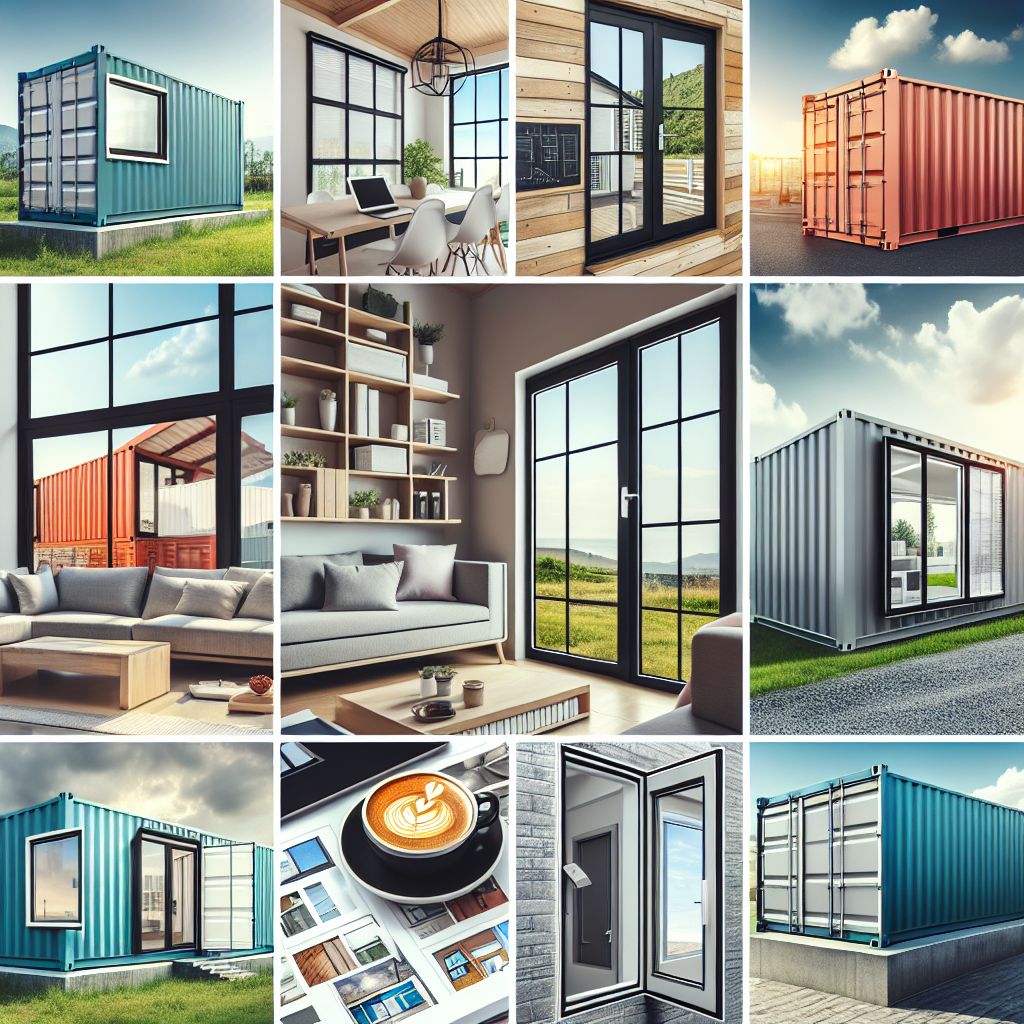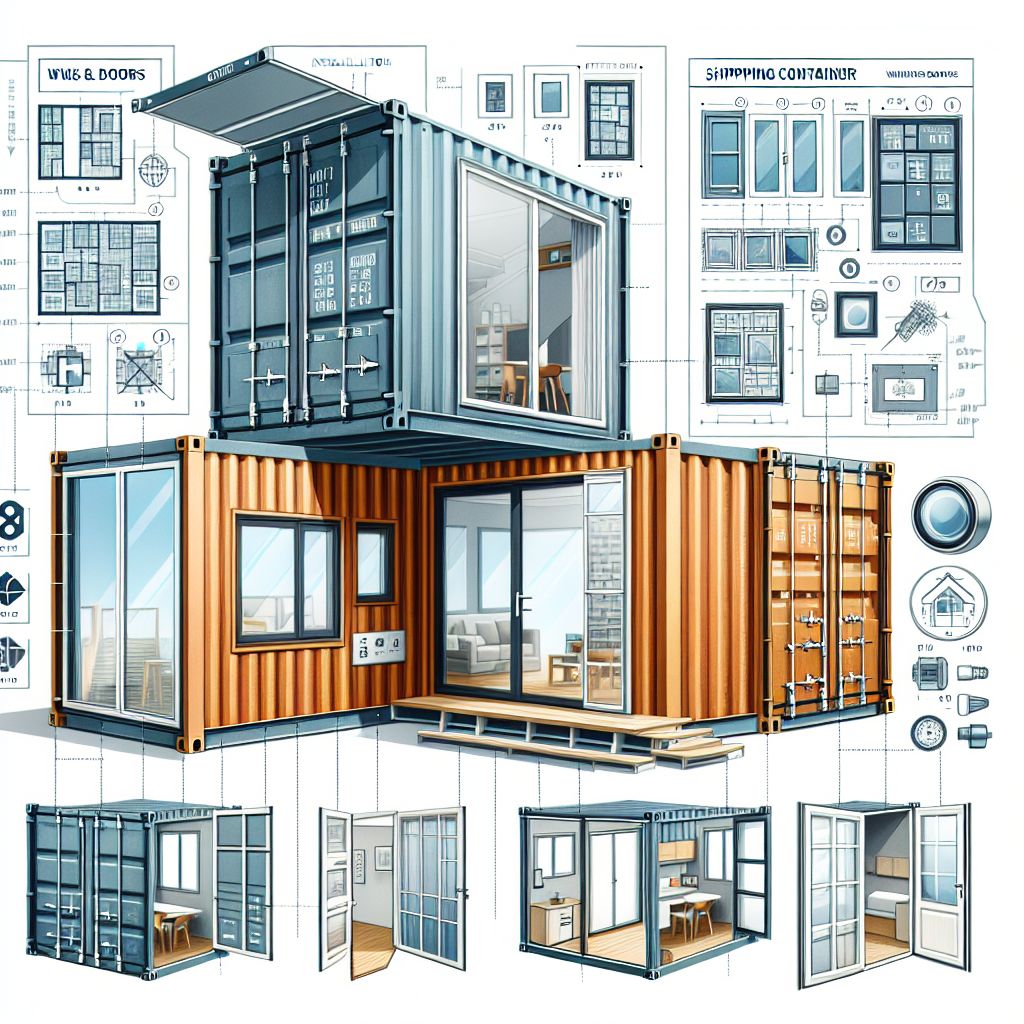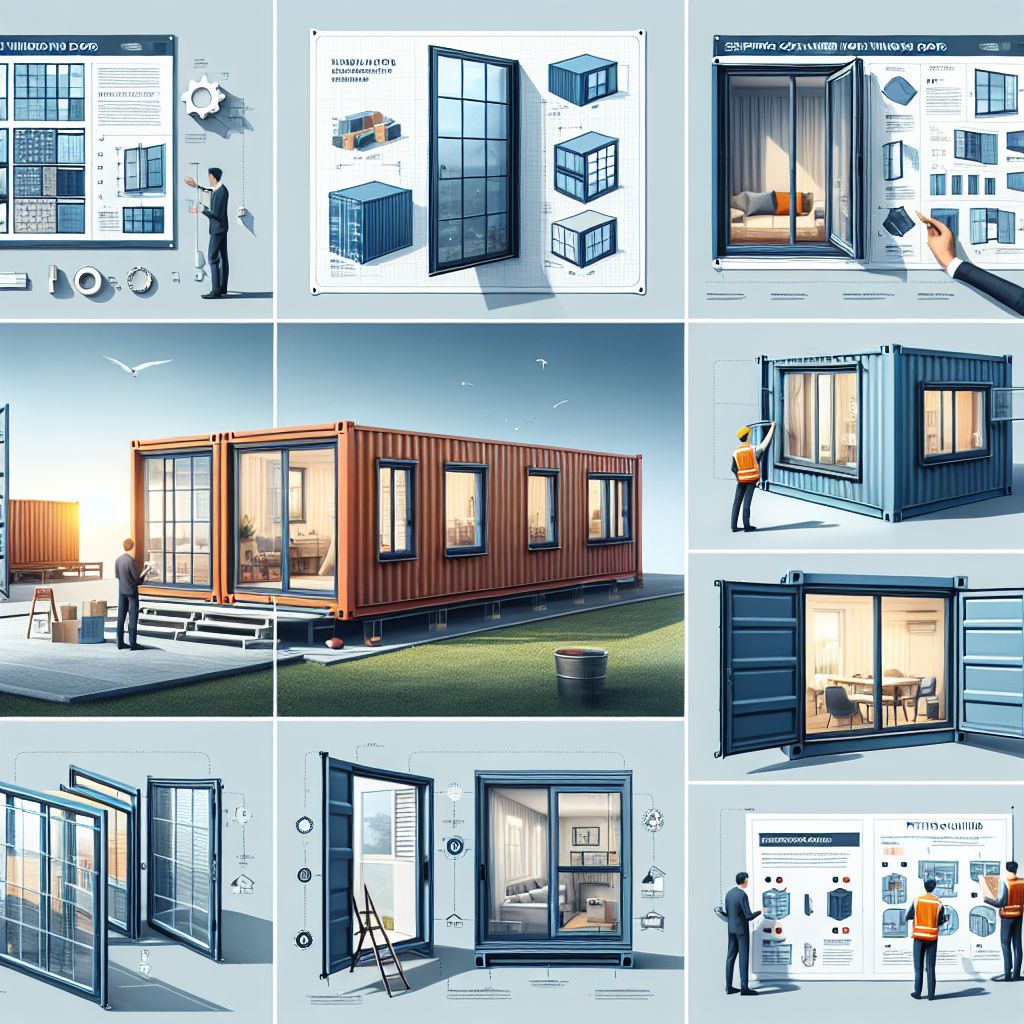
Key Takeaways
- Expect to pay between $100 to $400 for shipping container window and door installations, with variations based on size and style.
- Privacy windows are budget-friendly, typically costing $100 – $200, while larger sliding glass doors may range from $300 – $400.
- Choosing eco-friendly windows and doors can enhance your container home’s sustainability and energy efficiency.
- DIY installation can save money, but always consider the importance of proper sealing and structural reinforcement.
- Local zoning laws and building codes may impact your installation process, so check regulations before you begin.
Choosing the Right Windows & Doors
Before you start drilling and cutting, take a moment to think about what you need. Do you want a bright and airy space, or are you looking for privacy? Maybe you’re aiming for a balance of both. Consider your climate too – if you’re in a colder area, double-glazed windows might be your best bet for
Assessing Your Container Home’s Needs
Every container home is unique, and your needs will dictate the types of windows and doors you should install. Think about the direction your container faces, the local weather patterns, and how you want to use the space. For instance, a home office might benefit from large windows for ample daylight, while a bedroom might require smaller, privacy-oriented windows.
My Favorite Container Homes Resource
I compared the top 3 Container Home Guides
to discover the ultimate resource!
See my top recommendation here
Evaluating Different Window Types
There are several window types to consider for your container home:
- Fixed windows: These don’t open, but they’re great for letting in light and showcasing views.
- Sliding windows: These are space-savers and ideal for areas with limited room to maneuver.
- Awning windows: Hinged at the top, they open outward and are perfect for ventilation, even when it’s raining.
Comparing Door Designs
Doors, like windows, come in various styles:
- Sliding doors: These are practical for tight spaces and blend indoor and outdoor living.
- French doors: They add an elegant touch and are great for opening up a space.
- Roll-up doors: For an industrial look and easy access, consider a roll-up door, typically used in commercial container conversions.
Installation Costs at a Glance
Now, let’s talk money. Installation costs can vary, but knowing the average prices helps in planning your budget.
Breaking Down the Price Tag
The cost of installing windows and doors in your container home can vary widely based on several factors, including the size, type, and whether you’re doing it yourself or hiring a professional. Keep in mind that while DIY might save upfront costs, professional installation ensures a job well done, especially when it comes to weatherproofing and insulation.
Cost Comparisons by Type
Different types of windows and doors come with different price tags. For a detailed cost comparison, here’s a quick look:
- Privacy windows: $100 – $200
- Sliding glass doors: $300 – $400
- Concession windows for pop-up spaces: $100 – $200
Factor-Influencing Costs
Besides the type and size, other factors that influence cost include:
- Material quality
- Energy efficiency rating
- Complexity of the installation
Remember, investing in high-quality materials and proper installation can save you money in the long run by reducing the need for repairs and lowering energy bills.
Types of Windows & Doors for Container Homes
Let’s explore the different types of windows and doors in more detail, so you can make an informed decision for your container home.
Fixed Windows: A Solid Choice
Fixed windows are a solid choice for areas where you don’t need ventilation, like a picture window to frame a view. They’re often less expensive than operable windows and provide excellent insulation since they don’t open.
Sliding Windows: Maximizing Space
Sliding windows are perfect for saving space while still providing ample light and air. They slide horizontally, so you won’t need to account for extra space for them to open.
Awning Windows: Improving Ventilation
Awning windows are ideal for improving ventilation. They can be placed high on walls for privacy while still allowing fresh air to circulate. Plus, they’re a great option for rainy climates as they prevent water from entering when open.
Most importantly, choosing the right windows and doors is about balancing functionality, aesthetics, and sustainability. Eco-friendly options might cost more upfront, but they pay off by reducing your carbon footprint and energy bills.
Specialty Windows: Custom Solutions
If you have specific needs or want to make a statement, custom specialty windows are the way to go. They can be designed to fit any shape or size and come with various features like built-in blinds or tinted glass.
Sliding Doors: Effortless Access
Sliding doors offer effortless access to the outdoors and are great for merging indoor and outdoor spaces. They’re also a smart choice for smaller container homes where space is at a premium.
French Doors: Elegant Exits
French doors add a touch of elegance and can make any room feel more spacious. They’re perfect for leading out to a deck or garden and allow for plenty of natural light.
Bi-fold Doors: Modern Twist
Bi-fold doors provide a modern twist to traditional patio doors. They fold back completely, creating a wide-open space that’s perfect for entertaining or enjoying a seamless transition between your home and nature.
Roll-up Doors: Industrial Chic
For a more industrial chic look, roll-up doors are a standout choice. They’re commonly used in commercial container modifications but can add a unique touch to residential homes as well.
Installation Showcase
So, you’ve picked out the perfect windows and doors for your container home. Now, it’s time to install them. Here’s how to get your new windows and doors in place, step by step.
Preparing for Installation
Before you begin, it’s essential to prepare the area where you’ll be working. Clear out any furniture or obstacles and make sure the container walls are clean and free from rust or debris. If you’re cutting new openings, measure twice and cut once to avoid any costly mistakes.
Tools You’ll Need
For a successful installation, you’ll need the right tools. Here’s what should be in your toolbox:
- Measuring tape for precise measurements
- Marker or chalk to outline where you’ll cut or drill
- Metal cutting tools like a jigsaw or angle grinder
- Drill for making pilot holes
- Screws and rivets to secure your windows and doors
- Sealant and weather stripping for insulation and waterproofing
- Level to ensure your windows and doors are straight
- Safety gear, including gloves and eye protection
Remember, safety first! Always wear protective gear when working with tools and materials. For additional resilience tips and considerations when installing windows and doors in container homes, you can refer to our comprehensive stormproof guide.
Step-by-Step Installation Process
Now, let’s break down the installation process:
- Measure and Mark: Measure the space for your window or door carefully, then mark the area on the container where you’ll be cutting.
- Cut the Opening: Using your metal cutting tools, cut along the marked lines to create the opening. File down any sharp edges for safety.
- Frame the Opening: Frame the opening with steel or wood to provide support for your window or door and to give it something to attach to.
- Install the Window or Door: Place your window or door into the opening, using a level to make sure it’s perfectly horizontal and vertical.
- Secure in Place: Once it’s in the right position, secure your window or door using screws or rivets.
- Seal and Insulate: Apply sealant around the edges to prevent leaks, and add weather stripping to insulate and protect against drafts.
And there you have it! With some patience and careful work, you’ll have new windows and doors installed in your container home.

Size and Build Time Comparisons
Size matters when it comes to your container home’s windows and doors. It affects not just the look and feel of your space, but also the installation time and cost.
Small vs. Large Windows: What’s Best for You?
Small windows are more affordable and quicker to install. They’re great for bathrooms or closets where privacy is key. Large windows, on the other hand, let in more light and offer better views but require more work to install. They can also impact the structural integrity of your container, so it’s important to reinforce the frame accordingly.
Here’s a quick comparison: for more details, see our container vs traditional home costs.
- Small windows: Less material, lower cost, quicker installation
- Large windows: More material, higher cost, longer installation time
Standard Door Sizes or Custom Fit?
Standard door sizes are generally more cost-effective and easier to install. If you go for a custom fit, be prepared for higher costs and potentially longer build times. Custom doors can give your container home a unique look, but weigh the benefits against the extra time and money you’ll need to spend.
Quick Setup or Worth the Wait?
Quick setup options like pre-hung doors or ready-made windows can save time, but sometimes waiting for a custom piece that perfectly fits your vision is worth it. Consider your timeline and how much you’re willing to invest in getting the details just right.
Now, let’s look at some examples to help illustrate these points: For instance, the process of installing doors and windows in a shipping container home can be quite detailed and specific.
Choosing the right size and being aware of the build time can help you plan your project effectively and avoid any surprises along the way.
Local regulations can be a maze, but they’re there to ensure safety and community standards. Before you pick up that power tool, check with your local building authority. They’ll tell you what’s allowed and what’s not, which could save you from having to undo all your hard work.
Navigating Zoning Laws
Zoning laws can vary widely from one place to another. Some areas welcome container homes with open arms, while others have stricter codes. It’s all about safety, aesthetics, and making sure your home fits within the community. So, before you start, get the lowdown on what’s required in your area by reviewing different regional container home regulations.
Approval Comparisons by Region
Depending on where you live, the approval process for your container home can be straightforward or complex. In some regions, you might just need a simple permit, while in others, you could be looking at a series of inspections and approvals. It’s best to be prepared for the process, so you don’t hit any roadblocks along the way.
Pros and Cons: Sustainability Spotlight
When we talk about sustainability, it’s not just a buzzword; it’s a commitment to our planet. Choosing the right materials and designs for your container home windows and doors can significantly reduce your carbon footprint.
Eco-Benefits of Each Type
Eco-friendly windows and doors can make a big difference. For example, double-glazed windows keep heat in during winter and out during summer, slashing energy bills and reducing the need for heating and cooling. And materials like sustainably sourced wood or recycled aluminum for frames can also help the environment.
Mindful Material Choices
When selecting materials for your windows and doors, think about their environmental impact. Look for products with a low ecological footprint, like recycled or upcycled materials. And consider the longevity of the materials you choose; durable options mean fewer replacements down the line.
- Choose double-glazed windows for better insulation.
- Opt for materials with a low ecological footprint, such as sustainably sourced wood.
- Consider the durability of the materials to reduce the need for future replacements.
Container Homes Windows and Doors: Costs
| Window/Door Type | Installation Cost | Key Features |
|---|---|---|
| Privacy Window | $100 – $200 | – Sits above eye level for privacy 1 – Allows natural light without visibility 1 |
| Burglar Bar/Security Window | $300 – $400 | – Prevents theft, tampering, and vandalism 1 – Provides security for valuable inventory or documents 1 |
| Extra Large Window | $300 – $400 | – Ideal for supervisor offices, facility rooms, and storefronts 1 – Allows for better visibility and aesthetics 1 |
| Sliding Glass Door | $300 – $400 | – Allows for larger entryways without needing space for a swinging door 1 2 – Provides natural light and an inviting entrance 1 2 |
| Concession Window | $100 – $200 | – Useful for converting a container into a pop-up café or coffee shop 1 – Can be paired with rolling shutter doors for security 1 |

FAQs: Answering Your Top Questions
How Much Can I Save by DIYing My Window Installation?
DIY can save you a significant amount, often cutting costs in half. But remember, if you’re not experienced, you might end up spending more in the long run on repairs or energy losses due to improper installation. So, weigh your skills against potential long-term costs before deciding.
What Are the Most Energy-Efficient Windows for a Container Home?
The most energy-efficient windows for a container home are typically double-glazed with a low-E coating. They help maintain temperature control, reducing the need for heating and cooling systems, which saves energy and money.
Can I Install Large Windows without Compromising the Container’s Structural Integrity?
Yes, but it requires careful planning and reinforcement of the container’s structure. Consulting with an engineer or professional installer is recommended to ensure the safety and stability of your container home.
What Type of Door Offers the Best Security for a Container Home?
Steel doors are often considered the most secure option for container homes. They’re durable, resistant to forced entry, and can be fitted with high-quality locks for added security.
In conclusion, installing windows and doors in your container home is a big step towards creating a sustainable, comfortable, and secure living space. By considering the cost, types, installation process, and local regulations, you can make informed decisions that align with your eco-friendly goals. Remember, every choice you make has an impact, so choose wisely for the sake of your home and the planet.
When considering the installation of windows and doors in your shipping container home, it’s important to factor in both the cost and the type of windows and doors that will best suit your living space. Proper installation is crucial for maintaining the structural integrity of the container and ensuring that your home is well-insulated and secure. This guide will provide you with detailed information on the various options available and the associated costs.





